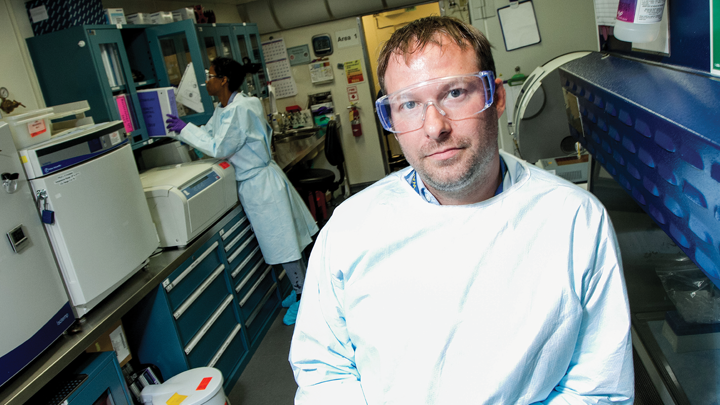Current Features
We’re Getting Invaded
What It’s Like Working At A Testing Lab During A Pandemic?

By DONNA CAMPISANO | College of Public Health
JEREMY CORRIGAN, A MOLECULAR BIOLOGIST, has managed the public health laboratory in northern California’s rural Humboldt County since 2010.
Pre COVID-19, Corrigan – a USF College of Public Health doctoral candidate in the online public health and clinical laboratory science and practice program – and his small staff did your run-of-the-mill testing and tracking. They typed influenza strains and looked for outbreaks of measles, mumps, chicken pox and other communicable diseases. They processed rabies tests, tested drinking water and tracked the quality of the shellfish in the nearby waters. Corrigan also oversees the lab’s bioterrorism division. He thought he had his 15 minutes of fame last year when his lab got a positive hit on a ricin sample, a poisonous agent sometimes used in bio warfare.
But that was then, and this is now. Ricin was tame by comparison.
“I’ll give you some perspective on how crazy it’s been,” Corrigan says when asked what life is like for him, with California spiking in COVID-19 cases. “We usually do 200-300 assays (a lab test) in a year. In the last four months, we’ve done 5,000. That’s insane for our tiny lab. We’re getting invaded by this coronavirus. We’re strictly doing COVID all day, every day. We were operating seven days a week, 12 hours a day. But my staff just couldn’t sustain that kind of intensity. We scaled back to six days a week and we’re now actively recruiting additional lab staff.”
Things are just as frenetic at Michael Perry’s lab in Albany, N.Y.
Perry, also a doctoral candidate in the college’s public health and clinical laboratory science and practice concentration, is the associate director of the Biodefense Laboratory at the Wadsworth Center, a New York State Department of Health lab. He and his biodefense co-workers help out in the center’s Virology Laboratory, processing COVID tests. When their shifts are over, they return to their biodefense work, testing specimens that come in for biothreat pathogens such as anthrax, ebola and plague.
“For the last four months, we’ve been testing for COVID almost nonstop,” says Perry, who’s been at Wadsworth 11 years. “At the beginning of the pandemic, we were working seven days and 80 hours a week, testing about 2,700 specimens daily. Now we’re down to about 60 or 70 hours per week and 1,500 tests daily. I fully expect it to pick up again in the fall, as more and more businesses open up.”
Lack of tests, slow results. What went wrong?
There’s been a national outcry at the lack of available testing in this country and the sometimes agonizing wait to get the results. Where do these lab scientists think things went awry?
Overwhelming demand and staffing issues have played a part, no doubt. But sourcing – or, more precisely, the lack of it – has been the biggest issue.
“It’s like baking,” Corrigan explains. “To make a batch of cookies, you need flour, sugar and eggs. Mix them all up, put them in the oven, and you come out with cookies. But imagine that this week you’re out of sugar, so you can’t make the cookies. And the next week, you have sugar but now you’re out of eggs. What I’ve done is try to increase my options so there are multiple different tests available.
“Luckily, my lab is part of the CDC, so we get federally provided reagents (a substance used to detect a pathogen or virus in a specimen). Our turnaround time is crushing the commercial labs. We get test results out the same day or within 24 hours. We’re fast because we need to be. We need to get patients identified and contacts traced.
“I think we’re doing pretty well with this, but instrumentation is a challenge. I have the funding, I have the purchase orders for the equipment, and I’m ready to roll, but now the instruments are on back order for months. I can’t increase my capacity, and that’s a huge frustration. These companies are doing their best, but demand is outpacing production. I don’t think the world or the U.S. was ready to ramp up this kind of testing.”
Perry has had his share of problems as well.
“Obtaining reagents in the beginning of the pandemic was tough,” Perry says. “All of the laboratories were competing for the same types of reagents and instruments. And there were only a few assays that had FDA approval, which limited stocks.”
Perry’s work-around was to have his lab validate their own assay, which allowed them to get test results in a very respectable 12-13 hours. And the New York State Department of Homeland Security and Emergency Services was essential in helping procure needed supplies.
COVID-19: ‘A perfect storm’
Dengue. Zika. Ebola. H1N1. Public health professionals are accustomed to dealing with vicious viruses. “Every pathogen we deal with is important,” Perry says, “because no matter what it is, correctly identifying it will make a difference in someone’s life.”
But COVID-19 really has no equal, the lab scientists say.
“I’ve worked with H1N1, ricin, anthrax and all these crazy dangerous toxins and diseases,” Corrigan says. “But the thing I’ve always been most afraid of is novel flu. It can go across the globe very quickly and have a huge effect on our population. COVID-19 is even worse. With a novel flu, you can adapt a vaccine and use antivirals that will have at least a partial effect. But with COVID-19, we have no drugs or vaccine. Speaking from a public health and molecular biologist standpoint, it’s really the perfect storm.”